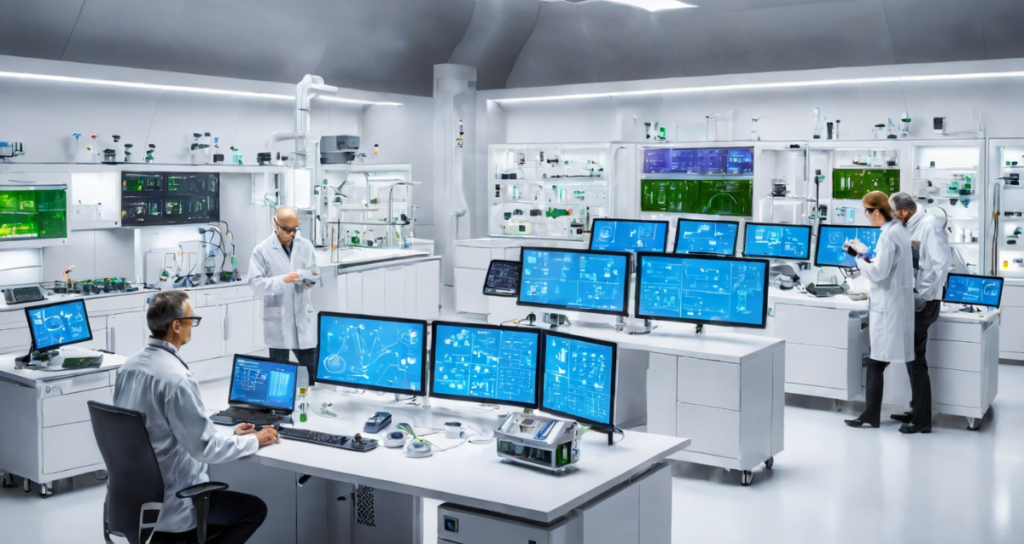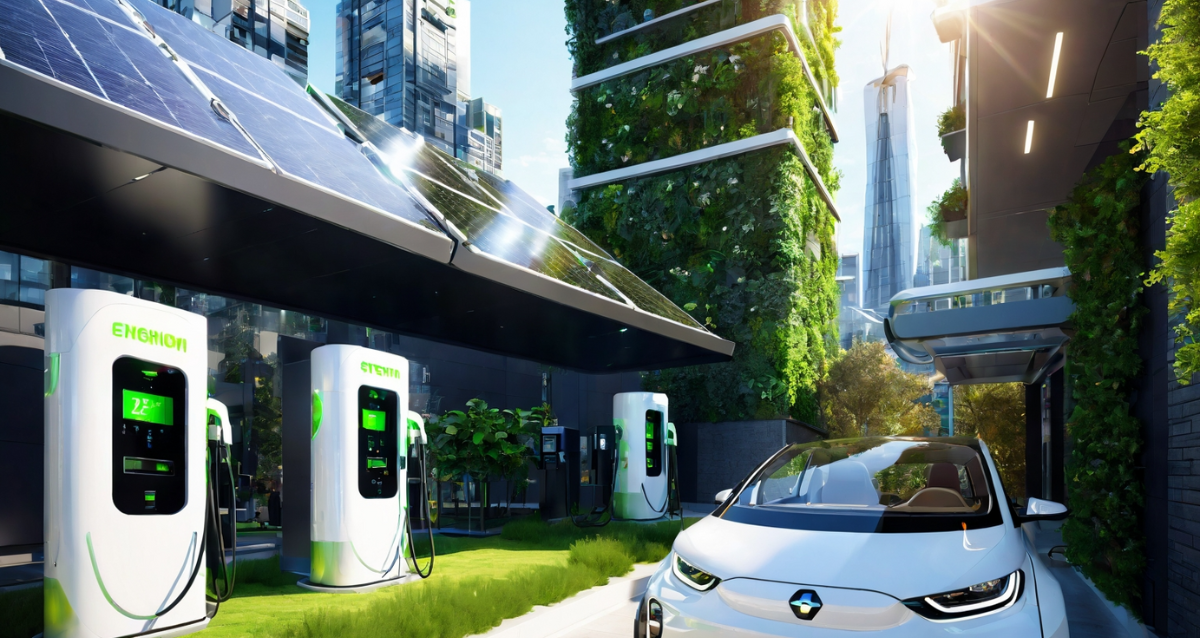In the globalized world of presently, sustainable living is vital as environmental issues keep developing. Adopting eco-friendly technologies for sustainable living has grown more urgent than before due to resource depletion, pollution, and warming temperatures. By reducing our environmental effects and conserving energy, these advances help to create a better planet for future generations.
Environmentally friendly innovations, including resource management and renewable energy solutions, are revolutionizing sectors like transportation, everyday living, and industry, aiming to reduce waste, enhance efficiency, and foster a sustainable future.
Table of Contents
Concept of sustainable technology
Sustainable technologies change design, construction, and use to reduce environmental impact while maximizing efficiency and effectiveness.
- Substitution: Consider environmentally beneficial materials in place of damaging ones. Perhaps we might substitute bioplastics derived from plants for conventional plastics. This is important for environmentally friendly technological items.
- Prevention: It is environmental harm and pollution calls for halting them before they start. One application of carbon capture technology is to stop carbon dioxide from reaching the atmosphere.
- Efficiency: The concept of efficiency is really about maximizing our resources’ value. For the same chore, energy-efficient appliances, for instance, require less electricity.
These values guarantee that eco-friendly technologies for sustainable living keep developing, therefore building a more resilient and resource-wise society.
Beyond Carbon Footprints: Smart and Eco-Friendly Technologies for Sustainable Living
Adopting technologies that support long-term environmental balance and societal well-being is part of sustainability, which extends beyond merely lowering carbon emissions. Rainwater collecting systems, Energy Star appliances, and home automation are just a few of the clever inventions that are revolutionizing homes and businesses with eco-friendly technology for sustainable living.
LED lighting and solar power minimize energy use, and smart irrigation and composting systems assist save water and trash. To maximize energy consumption, intelligent heating and cooling systems learn user patterns. Living a green life becomes efficient, convenient, and sustainable when these technologies are integrated.
AI: Revolutionizing Eco-Friendly Technologies for Sustainable Living

AI (artificial intelligence) is quickly changing many fields, but it has the biggest effect on healthy life. AI-powered solutions are becoming more and more important for improving the use of resources, speeding up the creation of green technologies, and giving people the power to make decisions that are better for the environment. Here are some important points that show how AI is used in eco-friendly tools for long-term living:
Smart Grids and Efficiency in Energy Use
AI programs can look at huge amounts of data from smart grids to figure out how to better distribute energy, predict how much will be needed, and incorporate green energy sources. This stops energy from going to waste and makes the energy system more stable and long-lasting.
Predictive Maintenance and Effective Use of Resources
Precision farming methods driven by artificial intelligence (AI) use sensors, drones, and data analytics to maximize fertilization, irrigation, and pest management. This shows a decrease in water and chemical use, which benefits the surroundings and helps farms to remain sustainable.
Waste Management and Recycling Optimization
Waste management and recycling need improvements. By helping to sort trash and streamline recycling operations, artificial intelligence can help to maximize efficiency and lower contamination risk. AI-driven systems could maximize garbage collecting strategies, therefore lowering fuel use and greenhouse gas emissions.
Precision farming and sustainable agriculture
AI-powered precision farming methods maximize pest management, fertilization, and irrigation by using sensors, drones, and data analytics. As a result, less water and chemicals are used, which lessens the impact on the environment and supports sustainable agriculture.
Development of Sustainable Materials
Artificial intelligence systems might speed up the identification and development of creative environmentally friendly materials, such as recyclable plastics and high-efficiency solar cell components, thereby producing durable goods. This hastens the shift to a circular economy and helps us to consume less limited resources.
Customized Guidance on Achieving Sustainability
AI-driven apps and platforms might provide people with customized recommendations for lowering their carbon footprint, conserving energy, and implementing more sustainable lifestyles.
Forecasting disasters and modelling climate change
Analyzing climate data and creating complex models capable of forecasting natural disasters, environmental changes, and other events depends on artificial intelligence. This helps us to more adequately equip ourselves for and lessen the effects of climate change.
Combining artificial intelligence with environmentally friendly solutions for sustainable living speeds the change to a more sustainable future. Artificial intelligence helps find creative ways to protect the environment, maximize the use of assets, and lower waste.
Advancing Sustainability Through Green Technology
Eco-Friendly Technologies for Sustainable Living are revolutionizing transportation, construction, and industries to reduce environmental impact and promote sustainability. Electric and hybrid vehicles, public transport innovations, and sustainable fuels like biofuels and hydrogen fuel cells are reducing carbon emissions and reducing reliance on fossil fuels.
Buildings, which are major energy consumers, are benefiting from these technologies, with LEED-certified buildings promoting energy efficiency, water conservation, and sustainable materials. Self-sufficient homes equipped with rainwater harvesting systems, smart energy management, and solar panels are making off-grid living more viable. The use of eco-friendly materials, including recycled and sustainably sourced resources, is also reducing the environmental impact of construction.
Industries and businesses are adopting eco-friendly technologies to lower their ecological footprint, implementing carbon-neutral strategies, investing in renewable energy sources, and using carbon offsets. Sustainable supply chains, incorporating recycled materials, reducing waste, and minimising transportation emissions, are becoming a priority for responsible businesses. Integrating renewable energy sources like wind and solar power into operations is also a priority.
Overcoming Obstacles and Adopting Sustainable Living Lifestyles with Eco-Friendly Technology
Although eco-friendly technologies for sustainable living present great promise, obstacles must also be overcome:
- The Digital Carbon Footprint
From the energy needed to run data centres and cloud computing consumes massive amounts of energy, to the materials needed to produce products, even digital innovations have an environmental impact. - Recycling Problems with E-Waste
A major issue related to the increasing volume of electronic garbage is improved recycling and disposal options needed. - The Right to Repair Movement
Encouragement of customers to fix their goods lowers e-waste and advances more eco-friendly technologies for sustainable living.
To promote sustainable living, individuals can adopt Eco-Friendly Technologies such as smart power strips, LED lighting, and unplugging devices. Sustainable shopping habits, such as purchasing energy-efficient appliances and supporting sustainable brands, can also help. Reducing data waste through file deletion, unsubscribing from unwanted emails, and efficient digital storage management can also reduce the environmental impact of digital consumption. By addressing these challenges, individuals and industries can work towards a more sustainable technological future.
Sustainable Living Eco-Friendly Technologies: Examining the Benefits Deeper
Green or clean tech is essential for a sustainable future. From personal homes to major industrial operations, eco-friendly technologies for sustainable living have many benefits. These are some main advantages:
- Environmental Preservation: Benefits to the environment may be the most obvious. Solar and wind energy reduce fossil fuel consumption, cutting greenhouse gas emissions and delaying global warming. Building with green materials reduces resource depletion and deforestation. Protection of the ecosystems of our world depends on these eco-friendly technologies for sustainable living.
- Enhanced Air and Water Quality: Sustainable mobility choices help to clear urban air through electric cars and public transit run on renewable energy. Less reliance on fossil fuels also decreases the possibility of oil spills and other environmental calamities that can damage water supplies.
- Resource Conservation: Smart irrigation systems, water-saving fixtures, and energy-efficient appliances assist in saving valuable resources including water and electricity. The environment gains from this as well as personal and company expenses are lowered.
- Economic Growth and Job Creation: New economic possibilities and employment in areas such as renewable energy, green construction, and sustainable manufacturing result from the development and application of eco-friendly technologies for sustainable living.
- Enhanced Quality of Life: In many respects, sustainable technology may raise our standard of living. Smart home solutions, for instance, may save money and lower energy use while improving comfort and convenience. Sustainable mobility choices and access to renewable energy can help to raise public health and welfare.
- Cost Savings: Although certain sustainable solutions may have a larger initial outlay, over time the savings might be noteworthy. For example, over time decreased utility expenses might result from energy-efficient equipment. Eventually, lowered energy prices allow renewable energy systems to pay for themselves.
Eco-friendly technologies for sustainable living seek to build a better future for everybody, not only lessen our effect. Adopting these technologies will help us to preserve our surroundings, strengthen the economy, and raise our standard of living.
A Bright Future for Sustainable Living: Green Technologies

The scene of eco-friendly technologies for sustainable living is always changing and promises a day when environmental awareness and creativity will coexist. Several important trends are guiding this interesting path:
1. Sustainability and artificial intelligence: A strong alliance
Artificial Intelligence (AI) is revolutionizing eco-friendly technologies for sustainable living by analyzing vast amounts of data and identifying patterns. It optimizes energy grids, predicting energy consumption and enhancing distribution across smart networks, minimizing waste and maximizing renewable energy use.
AI also predicts environmental changes by analyzing climate data, enabling better preparation and mitigation. It accelerates the development of sustainable materials like high-performance solar cell materials and biodegradable polymers, fostering innovation in eco-friendly technologies. AI continues to drive efficiency and sustainability in various sectors, reinforcing the importance of eco-friendly technologies for sustainable living.
2. Innovation at the forefront of next-generation renewable technology
Research and development are advancing environmentally friendly technology for sustainable living, resulting in groundbreaking innovations. Efficient solar panels are being developed to convert sunlight into electricity, making solar power a more viable energy source.
Biodegradable electronics are being developed to reduce e-waste and environmental impact. Advanced energy storage technologies, such as improved battery technology, are making renewable energy storage more efficient.
Smart agriculture, driven by sensors and data analytics, optimizes water and fertilizer usage, minimizing waste and reducing environmental harm. These advancements are paving the way for a more sustainable future in various industries.
3. Global Initiatives for a Better Future: Collaboration
Promoting eco-friendly technology for sustainable living and halting climate change requires international cooperation. Global accords such as the Paris Agreement establish emission reduction goals and promote investment in eco friendly technology products.
By putting laws like tax breaks and pollution limits into place to encourage the use of renewable energy, governments also play a significant role. Public awareness initiatives also encourage collective action toward a greener future by educating people about the advantages of sustainable living. Together, these initiatives guarantee a global movement toward environmental responsibility and eco-friendly technology for sustainable living.
Eco-friendly technologies for sustainable living show great potential going forward. Technology and sustainability may coexist to produce a better future for all through creative invention, encouraging teamwork, and environmental conscience a top priority.
Conclusion
A better planet depends on eco-friendly technologies for sustainable living. From smart houses to renewable energy, these developments assist to lessen our impact on the surroundings. Adopting environmentally friendly technology for sustainable living advances green business methods and transportation. Funding Eco-friendly technologies for sustainable living guarantees a rich and mindful future. As technology advances, adopting eco-friendly technologies for sustainable living is key to a greener world.
FAQs
1. How do eco-friendly technologies for sustainable living help the environment?
Eco-friendly technology lowers carbon emissions by encouraging waste reduction, energy efficiency, and renewable energy. Green transportation, smart grids, and sustainable building practices all reduce their negative effects on the environment. Individuals and businesses may help preserve the environment over the long run by incorporating these ideas.
2. What is the role of AI in eco-friendly technologies for sustainable living?
AI enhances sustainability by optimizing energy grids, predicting climate patterns, and improving waste management. It supports precision farming and helps create biodegradable materials, reducing resource consumption. AI-driven insights make energy and environmental management more efficient and impactful.
3. How can businesses adopt eco-friendly technologies for sustainable living?
By enhancing trash management, forecasting climatic trends, and optimizing energy networks, artificial intelligence (AI) improves sustainability. It lowers resource usage by assisting in the development of biodegradable materials and precision farming. Energy and environmental management is more effective and significant when AI-driven insights are used.
4. What are the benefits of using eco-friendly technologies in homes?
Smart home solutions like energy-efficient appliances, solar panels, and water-saving systems reduce utility bills and environmental impact. Automated systems optimize energy consumption, making homes more sustainable. These innovations improve convenience while promoting eco-conscious living.
5. What challenges exist in implementing eco-friendly technologies for sustainable living?
High initial costs, limited awareness, and technological infrastructure pose challenges to widespread adoption. E-waste recycling and digital energy consumption also need better management to ensure sustainability. However, innovation and supportive policies continue to drive progress toward a greener future.

